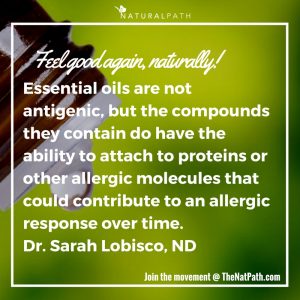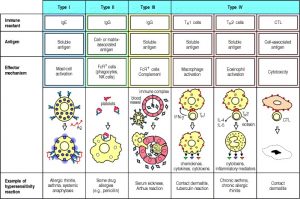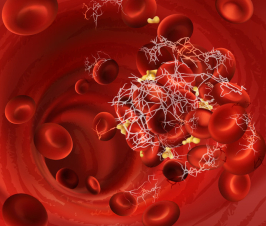What Would Make One “Allergic” in the First Place?
 With the increased popularity of essential oils,1,2 more clients and “oil enthusiasts” have been asking me this. Another popular and similar themed inquiry has been, “Can essential oils cause skin sensitization? If so, how can I avoid it?” I do not believe it’s only due to the increase in market growth of essential oils1,2 that these questions are popping up more in my inbox, however.
With the increased popularity of essential oils,1,2 more clients and “oil enthusiasts” have been asking me this. Another popular and similar themed inquiry has been, “Can essential oils cause skin sensitization? If so, how can I avoid it?” I do not believe it’s only due to the increase in market growth of essential oils1,2 that these questions are popping up more in my inbox, however.
Rise of the Allergies
There’s also been a rise in allergies and allergic diseases worldwide.3-4 This is especially true for the past 50 years in industrialized nations. Furthermore, sensitization rates to one or more common allergens reaching close to 40-50% in our school aged children worldwide.3
Of course, it’s imperative that I briefly mention that various safety considerations should always be implemented to decrease unintended side effects with any healing modality. Sometimes, improper usage can be mistaken for an “allergic” response. For example, with essential oils, an overdose or combining them with chemicals found in skin care products, may increase the probability of developing a skin sensitization or a negative response.
A More Important Question
What is often not considered in medicine, and in the aromatherapy community, is just as an important question as the 2 listed above. “What would have causedsomeone to have an allergic response to begin with?”
It’s not enough to be focusing on the avoidance of a substance and treating an unwelcome exposure to it (suppressing the symptom). As a naturopathic doctor, I deem it essential to “find and treat the cause” of this imbalanced immune response. Therefore, I will dive into some considerations on this question in a general overview and in Part II with more specifics to essential oils as the “trigger.”
First, let’s get you up-to-date on the properties of essential oils that could possibly cause an unwanted response that may be labeled as an “allergy.” This will help you gain a better understanding of the full picture of the complexity of the question.
Essential Oils and Allergies
In Part I of my essential oils and allergies article, I first outlined four types of allergic responses. This was to highlight that essential oils have only been linked to type IV, delayed hypersensitivity reactions (cell-mediated), related to their constituents being classified as haptens. In other words, essential oils are not antigenic themselves, but the compounds they contain do have the ability to attach to proteins or other allergic molecules that could contribute to an allergic response over time (a “delayed” reaction).
An allergy is generally accepted to be defined as a type 1, immediate hypersensitivity response mediated by an antibody (IgG) to the allergen.6,7 This means that an essential oil is not “allergic” in and of itself. Here’s a chart that will give you a visual of the difference form an immunobiology chapter.6
Skin Sensitization
Let’s discuss the topic of “skin sensitization.” I noted that in my 15+ years with pure essential oils, I have rarely seen this. There have been a few “sensitive type” clients, those prone to skin reactions and atopic disease, that, heavy handedly, have applied their way to this uncomfortable skin response. To prevent its occurrence, rotation of various essential oils and the recommended dosage should be used.
Purity of the Oil
Another consideration of any skin response to an essential oil is its purity of the oil itself. For example, “essential oils allergic responses” to terpenes are stated to be the result of an oxidation of synthetic terpenes found in fragranced skin care products. Combining pure oils with chemically-based skin care products will mount a potential response, because essential oils are “carrier molecules.”
Mixing Chemicals
These chemical mixes could be one mechanism linked to “entopy,”7,8 in which these chemical exposures are contributing to more people with symptoms of allergies. Entopy is defined in a 2010 article in Clinical and Experimental Allergyas follows:
While it is now generally accepted that mucosal local IgE has a role in the expression of atopic allergic disease, the concept of ‘local allergy’ in non-atopic subjects has been proposed, with the term ‘entopy’ given to this condition. Although there is increasing evidence supporting this paradigm, entopy is only applicable to a proportion of non-atopic patients, suggesting that other disease mechanisms exist to explain non-atopic disease. This review considers the evidence for local mucosal allergy in atopic and non-atopic individuals with an emphasis on diseases affecting the upper airways and eye.7
Other factors that I covered that may increase the probability of a type IV delayed hypersensitivity reaction included: skin aging, photosensitivity of certain essential oils, and those with “primed immune responses.”
But, What’s the Cause of Someone Reacting to Begin With?!
In the past, I wrote about using essential oils for modulating the immune system and relieving symptoms of sniffles and scratchy throats. I also gave a general overview of some of the causes for an overreactive immune response, including the health of the gut. Here’s an excerpt that highlights why a happy gastrointestinal tract is important for a calmer immune and respiratory system:
Specifically, I noticed that if a client is already inflamed and having symptoms of food sensitivities or gastrointestinal issues, they tend to have increased symptom manifestation during a particular season and are also more reactive to certain foods.
This is most often related to intestinal permeability.14-16 In fact, in one research article the authors concluded:
In this review, we describe the importance of properly balanced intestinal permeability in oral tolerance induction and address the processes involved in damaging the intestinal barrier in the sensitized epithelium and during allergic reactions. We conclude by speculating on the effect of increased intestinal permeability on the onset of sensitization towards dietary antigens.14
Therefore, for a healthy immune and respiratory tract, it’s important to pay attention to your belly.
Here’s another post that provides a brief overview on what factors are related to an imbalanced immune response and four natural remedies with essential oils for the ahchoos.
I hope you now have a fuller understanding of the complexity of the question and the factors linked to a hypersensitivity reaction mediated by the immune system.
I will next dive into some considerations on what would causesomeone to have an essential oil “trigger” this response.
In Part II, I’ll continue on with the discussion on what factors may make someone have a negative reaction to an essential oil.
References:
- Technavio. Increasing popularity of aromatherapy products to propel growth in the global essential oils market by 2020. Health and Wellness Report: Infiniti Research Limited. July 1, 2016. https://www.technavio.com/pressrelease/increasing-popularity-aromatherapy-products-propel-growth-global-essential-oils-market
- Grand View Research. Essential Oil Market Analysis By Product (Orange, Corn Mint, Eucalyptus, Citronella, Peppermint, Lemon, Clove Leaf, Lime, Spearmint), By Application (Medical, Food & Beverage, Spa & Relaxation, Cleaning & Home) And Segment Forecasts To 2024. Grand View Research, Inc. August 2016. Report ID: 978-1-68038-549-6. (187 Pages). http://www.grandviewresearch.com/industry-analysis/essential-oils-market
- American Academy of Asthma, Allergy, and Immunology. Allergy Statistics. AAAAI Website. Available at: http://www.aaaai.org/about-aaaai/newsroom/allergy-statistics. Accessed April 10, 2017.
- Stone, KD. Atopic diseases of childhood [abstract]. Curr Opin Pediatr[online]. 2002 Oct;14(5):634-46. https://www.ncbi.nlm.nih.gov/pubmed/12352260
- Moreno, MA. Atopic Diseases in Children. JAMA Pediatr. 2016;170(1):96. doi:10.1001/jamapediatrics.2015.3886
- Janeway CA Jr, Travers P, Walport M, et al. Immunobiology: The Immune System in Health and Disease. 5th edition. New York: Garland Science; 2001. Chapter 12, Allergy and Hypersensitivity. Available from: https://www.ncbi.nlm.nih.gov/books/NBK10756/
- Powe DG, Bonnin AJ, Jones NS. ‘Entopy’: local allergy paradigm. Clin Exp Allergy. 2010 Jul;40(7):987-97. doi: 10.1111/j.1365-2222.2010.03536.x.
- Rosen D. Seasonal Allergies: An Integrative Approach to Atopic Disorders. Integrative Practitioner. http://www.integrativepractitioner.com/topics/environmental-health/seasonal-allergies-an-integrative-approach-to-atopic-disorders/
 SARAH LOBISCO, ND, is a graduate of the University of Bridgeport’s College of Naturopathic Medicine (UBCNM). She is licensed in Vermont as a naturopathic doctor and holds a Bachelor of Psychology from State University of New York at Geneseo.
SARAH LOBISCO, ND, is a graduate of the University of Bridgeport’s College of Naturopathic Medicine (UBCNM). She is licensed in Vermont as a naturopathic doctor and holds a Bachelor of Psychology from State University of New York at Geneseo.
Dr. LoBisco speaks professionally on integrative medical topics, has several journal publications, and has completed her postdoctoral training as a certified functional medicine practitioner. Dr. LoBisco currently incorporates her training in holistic medical practices and conventional medicine through writing, researching, private wellness consultations, and through her independent contracting work for companies regarding supplements, nutraceuticals, essential oils, and medical foods.
Dr. LoBisco also enjoys continuing to educate and empower her readers through her blogs and social media. Her recent blogs about living naturally in our complex world and on the applications of essential oils can be found at www.dr-lobisco.com and at www.saratoga.com/living-well. Her new book BreakFree Medicine is now available on Amazon and Barnes & Noble.


















